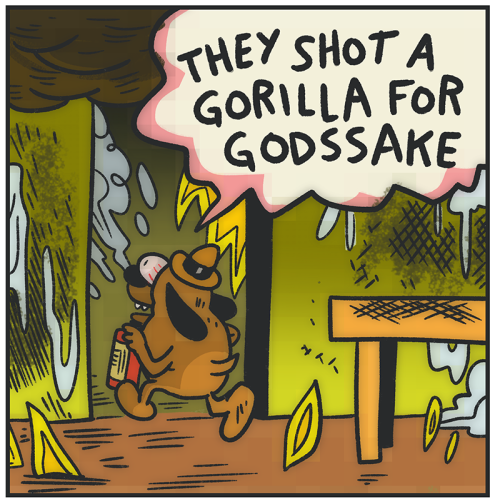Thank You Canada 🇨🇦

thank you Canada 🇨🇦
More Posts from Sipurrim and Others
Words to use instead of “said” organized by emotion/intention 2.0
Said is NOT a bad word. ~75% of the time, it’s all you need. But here’s some alternative when you really need to spice up that dialogue!
Use sparingly for more impact - especially the more dramatic verbs. Emotion and intent are complex! I tried to reduce redundancy as much as I could, but some words are simply going to be in multiple categories. i.e. “anger” and “loud” share a lot of words
This is a living document and will be updated whenever I think of new words.
Afficher davantage
Don't ever hesitate. Reblog this. TUMBLR RULE. When you see it, REBLOG IT.
Depression Hotline:1-630-482-9696
Suicide Hotline:1-800-784-8433
LifeLine:1-800-273-8255
Trevor Project:1-866-488-7386
Sexuality Support:1-800-246-7743
Eating Disorders Hotline:1-847-831-3438
Rape and Sexual Assault:1-800-656-4673
Grief Support:1-650-321-5272
Runaway:1-800-843-5200, 1-800-843-5678, 1-800-621-4000
Exhale:After Abortion Hotline/Pro-Voice: 1-866-4394253
Child Abuse:1-800-422-4453
UK Helplines:
Samaritans (for any problem):08457909090 e-mail jo@samaritans.org
Childline (for anyone under 18 with any problem):08001111
Mind infoline (mental health information):0300 123 3393 e-mail: info@mind.org.uk
Mind legal advice (for people who need mental-health related legal advice):0300 466 6463 legal@mind.org.uk
b-eat eating disorder support:0845 634 14 14 (only open Mon-Fri 10.30am-8.30pm and Saturday 1pm-4.30pm) e-mail: help@b-eat.co.uk
b-eat youthline (for under 25’s with eating disorders):08456347650 (open Mon-Fri 4.30pm - 8.30pm, Saturday 1pm-4.30pm)
Cruse Bereavement Care:08444779400 e-mail: helpline@cruse.org.uk
Frank (information and advice on drugs):0800776600
Drinkline:0800 9178282
Rape Crisis England & Wales:0808 802 9999 1(open 2 - 2.30pm 7 - 9.30pm) e-mail info@rapecrisis.org.uk
Rape Crisis Scotland:08088 01 03 02 every day, 6pm to midnight
India Self Harm Hotline:00 08001006614
India Suicide Helpline:022-27546669
Kids Help Phone (Canada):1-800-668-6868, Free and available 24/7
suicide hotlines;
Argentina:54-0223-493-0430
Australia:13-11-14
Austria:01-713-3374
Barbados:429-9999
Belgium:106
Botswana:391-1270
Brazil:21-233-9191
China:852-2382-0000
(Hong Kong:2389-2222)
Costa Rica:606-253-5439
Croatia:01-4833-888
Cyprus:357-77-77-72-67
Czech Republic:222-580-697, 476-701-908
Denmark:70-201-201
Egypt:762-1602
Estonia:6-558-088
Finland:040-5032199
France:01-45-39-4000
Germany:0800-181-0721
Greece:1018
Guatemala:502-234-1239
Holland:0900-0767
Honduras:504-237-3623
Hungary:06-80-820-111
Iceland:44-0-8457-90-90-90
India:022 2754 6669
Israel:09-8892333
Italy:06-705-4444
Japan:3-5286-9090
Latvia:6722-2922, 2772-2292
Malaysia:03-756-8144
(Singapore:1-800-221-4444)
Mexico:525-510-2550
Netherlands:0900-0767
New Zealand:4-473-9739
New Guinea:675-326-0011
Nicaragua:505-268-6171
Norway:47-815-33-300
Philippines:02-896-9191
Poland:52-70-000
Portugal:239-72-10-10
Russia:8-20-222-82-10
Spain:91-459-00-50
South Africa:0861-322-322
South Korea:2-715-8600
Sweden:031-711-2400
Switzerland:143
Taiwan:0800-788-995
Thailand:02-249-9977
Trinidad and Tobago:868-645-2800
Ukraine:0487-327715
✦TAG SYSTEM✦
GENERAL TAGS
❥ Reblog (General)
❥ Reblog (Writing)
❥ Reblog (Art)
❥ Reblog (Reference)
❥ Reblog (Own)
SPECIFIC TAGS
❥ Vocabulary
❥ Writing Tips
❥ Worldbuilding
❥ Art Tips
❥ Colour Palettes
❥ Animal Anatomy
PERSONAL TAGS
❥ Sipurim Illustrates
❥ Sipurim Purrs

Seeing Her In A Child - Submitted by pill0wc4se
#06051A #151A3A #152C71 #6D80A7 #BBCFED #DCEAF6 #C1B7CE

As I have been promising for years, the eye color chart is all cleaned up and ready to be shared! I'm totally ok with this being saved and passed around, that's why all my info is on it.
Basic image description is in alt, and a full transcript of all text in the image is under the cut.
This model has been in a process of expansion and tweaking for a very long time. Huge huge thanks to all the folks who contributed and hunted down photos, helped me name all the colors, and gave the final proofs!
Sparrow's Eye Color Chart 2025 Edition
Eye colors in cats are difficult to model because they vary to a significant extent on two axes. This is my best attempt at a general model of cat eye color based on observation and research into how eye color works across species.
Pigmentation refers to the amount of pigment in the colored layer of the iris. Higher pigmentation causes darker colors.
Refraction means the extent to which light is scattered in the structures of the iris. Higher refraction causes deeper blues or greens.
Eye colors are related to coat color, but not as closely as breed standards might have you believe! Most coat colors can have most eye colors outside of purebred lines selected to meet breed standard.
What Color Are My Cat's Eyes?
Color names are descriptive of the actual color of the cat's eyes - I chose them all to sound nice so that breeders can use them if desired. Note that breed standards have a much broader use of color names - "Amber", for example, may include much of the golden to orange range.
Colors are based on pictures of cats in full white light (such as midday sun fully illuminating the eye), and tweaked to look good on properly color-calibrated screens. Always determine eye colors based on how they look in full light.
Main Block
standard eye colors possible with most pelts
Every cat is assumed to have genes that specify some genetic eye color in the main block, but certain other alleles can depigment the eyes partially or completely, creating the lower block.
Pigmentation and Refraction are modeled here as dependent on multiple genes, which seems to best fit the wide spectrum of possibilities in cats. The actual number of genes is unknown and could be very many, but for simplicity they are shown here on a scale from 1-7.
In theory, the genetic eye colors of the offspring should tend to fall somewhere between the genetic eye colors of the parents. Then, any depigmentation factors are applied, which may result in an actual eye color somewhere below the genetic eye color.
Lower Block
occur with phenotypes which cause depigmentation of the iris.
Gray-blues: Fairly rare coloration. The cause of gray eyes in humans is not well understood, but one theory is that collagen or very small amounts of pigment in the eye alter the scattering of light.
Blues: Most common depigmented colors. Can be caused by white spotting/dominant white, colorpoint, and sometimes mocha. There are also multiple Dominant Blue-eye (DBE) mutations known which cause blue eyes as the main effect.
Albinistic: Caused by complete albinism, which also fully depigments the back layer of the iris meant to keep light from getting through. This allows the red color from the retinal blood vessels to bleed through, and also causes poor visual acuity.
Following is a list of all eye colors shown on the main diagram. Rows are pigmentation levels starting from the highest pigmentation, refraction increases from left to right.
Main Block: Copper, Chestnut, Umber, Walnut, Earthen, Olive, Moss; Ochre, Caramel, Bronze, Serpentine, Artichoke, Fern, Forest; Orange, Amber, Brass, Peridot, Avocado, Clover, Malachite; Saffron, Butterscotch, Shrub, Spring, Jade, Pine, Emerald; Gold, Citron, Pear, Lime, Mantis, Grass, Viridian; Yellow, Chartreuse, Sprout, Laurel, Mint, Turquoise, Teal; Canary, Chiffon, Honeydew, Sage, Celadon, Aqua, Cerulean.
Lower Block: Gray-blues: Frost, Opal, Flint, Storm, Steel, Slate, Cadet. Blues: Ice, Powder, Celeste, Sky, Azure, Lapis, Cobalt. Albinistic: Pink, Mauve, Lavender, Periwinkle, Cornflower, Royal, Indigo.
Combo Colors
Cats can exhibit a few different heterochromia types, most commonly a blue with a non-blue. The other most common cause for heterochromia appears to be localized hyperpigmentation, which can be caused by damage to the eye. It can also happen simply due to differing iris structure or unusual pigment migration within the iris.
It is also relatively common for the center of the eye to be a slightly different color, without being marked enough to constitute full heterochromia. My provisionary term for this is "dual-toned". The boundary between this and "true" central heterochromia is somewhat subjective.
For any form of heterochromia or dual-toned eyes, my recommendation for describing them is to note both colors with a slash. For dual-tones, I generally write the outer color before the center one.
Complete Heterochromia Blue/non-blue is commonly caused by white spotting/dominant white, other combos are rare.
Sectoral Heterochromia Blue/non-blue sometimes occurs with white spotting/dominant white. Can also be from hyperpigmentation.
Central Heterochromia Can occur due to hyperpigmentation, uneven pigment distribution, or iris structure. More common in certain breeds.
Dual-toned Irises Relatively small differences in central eye color are common in cats.
Iris Atrophy Iris atrophy due to old age can cause a distinctive lighter ring in the center of the iris.
All writing, art, and chart design ©Sparrow Hartmann 2025
Icon designs are released to the Creative Commons under a CC-BY-SA license and will be made available for download.
Go to sparrows-garden.com for more genetics resources!
just once I want to see a good post critiquing makeup culture that doesn’t turn out to be made by some janky radfem blog
-
 bookwormandsci-fifanatic reblogged this · 1 week ago
bookwormandsci-fifanatic reblogged this · 1 week ago -
 bookwormandsci-fifanatic liked this · 1 week ago
bookwormandsci-fifanatic liked this · 1 week ago -
 jesterpanic reblogged this · 1 week ago
jesterpanic reblogged this · 1 week ago -
 loksmum reblogged this · 1 week ago
loksmum reblogged this · 1 week ago -
 loksmum liked this · 1 week ago
loksmum liked this · 1 week ago -
 alrightythenbabe reblogged this · 1 week ago
alrightythenbabe reblogged this · 1 week ago -
 nice-try-time-isnt-real reblogged this · 1 week ago
nice-try-time-isnt-real reblogged this · 1 week ago -
 nice-try-time-isnt-real liked this · 1 week ago
nice-try-time-isnt-real liked this · 1 week ago -
 dkdrawss liked this · 1 week ago
dkdrawss liked this · 1 week ago -
 strawsnolongeravailable reblogged this · 1 week ago
strawsnolongeravailable reblogged this · 1 week ago -
 joycrispy liked this · 1 week ago
joycrispy liked this · 1 week ago -
 spicy-suns liked this · 1 week ago
spicy-suns liked this · 1 week ago -
 elmosmagiccuntbook liked this · 1 week ago
elmosmagiccuntbook liked this · 1 week ago -
 kiwi-kittykat reblogged this · 1 week ago
kiwi-kittykat reblogged this · 1 week ago -
 somesortofitalianroast reblogged this · 1 week ago
somesortofitalianroast reblogged this · 1 week ago -
 devolution-spiral reblogged this · 1 week ago
devolution-spiral reblogged this · 1 week ago -
 devolution-spiral liked this · 1 week ago
devolution-spiral liked this · 1 week ago -
 musicalyeetreblr liked this · 1 week ago
musicalyeetreblr liked this · 1 week ago -
 carthus-flame-arc reblogged this · 1 week ago
carthus-flame-arc reblogged this · 1 week ago -
 eternal-drifts liked this · 1 week ago
eternal-drifts liked this · 1 week ago -
 50tabsopen liked this · 1 week ago
50tabsopen liked this · 1 week ago -
 estradiol2mg-blog reblogged this · 1 week ago
estradiol2mg-blog reblogged this · 1 week ago -
 watermelonrandom liked this · 1 week ago
watermelonrandom liked this · 1 week ago -
 justgoji reblogged this · 1 week ago
justgoji reblogged this · 1 week ago -
 kt--extinction reblogged this · 1 week ago
kt--extinction reblogged this · 1 week ago -
 kt--extinction liked this · 1 week ago
kt--extinction liked this · 1 week ago -
 crhodey reblogged this · 1 week ago
crhodey reblogged this · 1 week ago -
 raleigh-nc-official-totally-real reblogged this · 1 week ago
raleigh-nc-official-totally-real reblogged this · 1 week ago -
 theringmasterofchaos reblogged this · 1 week ago
theringmasterofchaos reblogged this · 1 week ago -
 alaritheaurora reblogged this · 1 week ago
alaritheaurora reblogged this · 1 week ago -
 alaritheaurora liked this · 1 week ago
alaritheaurora liked this · 1 week ago -
 bri-of-the-shire liked this · 1 week ago
bri-of-the-shire liked this · 1 week ago -
 bloodofghostbur reblogged this · 1 week ago
bloodofghostbur reblogged this · 1 week ago -
 gemgdynamxght reblogged this · 1 week ago
gemgdynamxght reblogged this · 1 week ago -
 gemgdynamxght liked this · 1 week ago
gemgdynamxght liked this · 1 week ago -
 doggogills-but-worse reblogged this · 1 week ago
doggogills-but-worse reblogged this · 1 week ago -
 doggogills-but-worse liked this · 1 week ago
doggogills-but-worse liked this · 1 week ago -
 jungleboy-cruise reblogged this · 1 week ago
jungleboy-cruise reblogged this · 1 week ago -
 rosesfromthegarden liked this · 1 week ago
rosesfromthegarden liked this · 1 week ago -
 whymsie-theautumnprince liked this · 1 week ago
whymsie-theautumnprince liked this · 1 week ago -
 eli5805 liked this · 1 week ago
eli5805 liked this · 1 week ago -
 fmajorenthusiast liked this · 1 week ago
fmajorenthusiast liked this · 1 week ago -
 believeinlostsouls liked this · 1 week ago
believeinlostsouls liked this · 1 week ago -
 maguskuro reblogged this · 1 week ago
maguskuro reblogged this · 1 week ago -
 sunscribble305409 reblogged this · 1 week ago
sunscribble305409 reblogged this · 1 week ago -
 blackbeardsflag liked this · 1 week ago
blackbeardsflag liked this · 1 week ago -
 timeywimeydemigod reblogged this · 1 week ago
timeywimeydemigod reblogged this · 1 week ago -
 timeywimeydemigod liked this · 1 week ago
timeywimeydemigod liked this · 1 week ago














